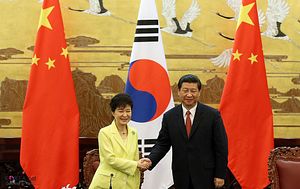On a recent TV discussion program I attended in Seoul, the host used the concept of a “security dilemma” to describe how South Korea finally agreed to deploy the Terminal High Altitude Area Defense (THAAD) system on its territory, particularly after years of hesitation. Indeed, “security dilemma,” or more specifically the “secondary alliance dilemma” may best describe South Korea’s difficult decision over the deployment of THAAD on its own territory.
According to Glenn H. Snyder, after the formation of alliance, states move to the second phase of alliance dilemma:
…in which their choices are no longer whether to ally or not, but how firmly to commit themselves to the proto-partner and how much support to give that partner in specific conflict interactions with the adversary.
This is defined South Korea’s final decision to deploy THAAD. Interestingly, the security logic behind THAAD may be limited. Reports indicate that the THAAD system may only guard a specific area of South Korea — a portion that does not include the Seoul metropolitan area. Meanwhile, in Beijing’s view, the true capability of the THAAD system, especially its surveillance abilities, go well beyond the practical security concerns of South Korea. Given these factors, and in view of alliance politics, South Korea’s decision is very much based on doing its committed duty for the alliance, although the allegedly pressing missile threats from the North also play a role.
Now the real problem lies in the long-term consequences that may be brought by THAAD deployment. There are two aspects to watch. First, contrary to the current tacit balance in the Korean Peninsula among great powers (such as China and the U.S.), the deployment of THAAD may possibly “entrap” South Korea should there be a major China-U.S. conflict, in which South Korea may not necessarily share all the interests with its ally, particularly when it concerns China. Second, from a political-psychological view, China’s reactions, which may not be simply limited to certain economic measures, may loom large in the long term. For example, the “trust-building” process initiated and propagandized by the South Korean government more or less will fall back, and China may need to seriously reassess South Korea’s role in its overall diplomacy with neighboring countries.
After all, China has a solid reason to be unhappy, just as South Korea had its own reasons to finally agree to deploy THAAD. The Chinese view about the “ulterior motive” of THAAD deployment can be perfectly described by an historical allusion to the story of Liu Bang, the first emperor of Han Dynasty. At the Hongmen banquet, would-be assassin Xiang Zhuang performed a sword dance to provide cover for his attempt on Liu Bang’s life. This gave rise to an idiom still in use today to describe the use of a pretext to disguise a nefarious plan: “Xiang Zhuang performs a sword dance, but his mind is on the Duke of Pei (Liu Bang)” (项庄舞剑,意在沛公). For China, THAAD is the sword dance. The question is, does South Korea really want to play the role of Xiang Zhuang?

































